China Pistols (Article III)
Chinese Mauser C96 M712 - Type 80.
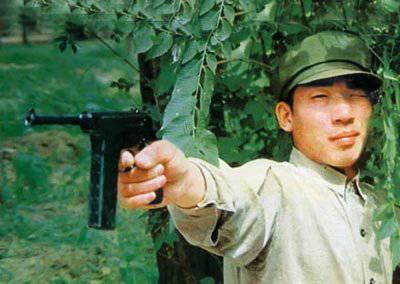 The first model of the weapon in this article could have been omitted, since at the moment such weapons are classified as submachine guns, but since they were created on the basis of the 30 model of the last century, which was considered a pistol, we will also designate him the same way. This is a gun Type 80, which is a slightly modified Mauser M712, the same Mauser, who knew how to shoot the queue. In general, the decision to adapt such weapons is justified, since submachine guns occupy a significant place in many armies of the world as weapons of armored vehicle crews and all others who need these weapons first of all for self-defense, and not for the assigned tasks. However, a number of flaws in the weapon itself and the cartridge that was used in it made a good waste of money from a good idea. However, the weapon was put into service, despite its obvious flaws. Let's try to get acquainted with this sample in more detail.
The first model of the weapon in this article could have been omitted, since at the moment such weapons are classified as submachine guns, but since they were created on the basis of the 30 model of the last century, which was considered a pistol, we will also designate him the same way. This is a gun Type 80, which is a slightly modified Mauser M712, the same Mauser, who knew how to shoot the queue. In general, the decision to adapt such weapons is justified, since submachine guns occupy a significant place in many armies of the world as weapons of armored vehicle crews and all others who need these weapons first of all for self-defense, and not for the assigned tasks. However, a number of flaws in the weapon itself and the cartridge that was used in it made a good waste of money from a good idea. However, the weapon was put into service, despite its obvious flaws. Let's try to get acquainted with this sample in more detail.The appearance of a Type 80 pistol is different from its progenitor. First of all, it should be noted that the weapon shop is inclined forward, which facilitates its replacement, and also has a positive effect on the reliability of filling the cartridge into the chamber. The pistol grip was also changed, got a more ergonomic handle. A remarkable point is that the pistol sights are designed for firing up to 1000 meters, but it is very problematic to use weapons at a distance longer than 100-150 meters. Apparently for this reason, the sights in the near future after the release of the first pistols became unregulated and were shot at a firing distance of fifty meters. Almost immediately above the handle of the weapon is located the switch of the safety lock translator of fire modes, which was not very convenient and excluded its use by the hand holding the pistol. In order to protect the weapon and preserve its appearance, individual parts of the weapon were blued. In general, the appearance of the weapon is not the most attractive and very much resembles those samples that can be found in the museums of the Ministry of Internal Affairs among homemade versions of firing devices.
 Unfortunately, the Chinese did not manage to completely repeat the once truly legendary model of weapons. Despite the fact that the weapons shop was located at an angle to facilitate the supply of ammunition, pistol failures associated with sticking cartridges when serving, were still present. And if it was possible to make more than 10 shots in automatic fire mode, the gun itself overheated so much that the probability of an involuntary shot, even with the open bolt, was actually equal to 100%. However, a similar problem was the original Mauser C96 M712. The solution to this problem was found very quickly. So initially the weapon used shops with a capacity of 20 cartridges, but soon a shop with a capacity of 10 cartridges became standard. Well, since there were no more 10 cartridges in it, there was no problem. True, stores with a capacity of 20 cartridges still continued to produce, but they were already "stores increased capacity." Just like his progenitor, the Type 80 pistol was equipped with a wooden holster, which had the opportunity to be fastened on the back of the handle and used as a butt. However, in addition to the wooden holster, the pistol could be completed with a frame shoulder rest. A remarkable point was also the fact that the barrel of the pistol was welded to the movable receiver, that is, the repair of such weapons was more expensive than the original German pistol in which the barrel was screwed into the receiver. In general, the Chinese did not manage to create something special, so the Type 80 is still the same C96 M712 with minor changes. Some of these changes made the weapon worse, some better, but overall the Type 80 is incomparable with the original.
Unfortunately, the Chinese did not manage to completely repeat the once truly legendary model of weapons. Despite the fact that the weapons shop was located at an angle to facilitate the supply of ammunition, pistol failures associated with sticking cartridges when serving, were still present. And if it was possible to make more than 10 shots in automatic fire mode, the gun itself overheated so much that the probability of an involuntary shot, even with the open bolt, was actually equal to 100%. However, a similar problem was the original Mauser C96 M712. The solution to this problem was found very quickly. So initially the weapon used shops with a capacity of 20 cartridges, but soon a shop with a capacity of 10 cartridges became standard. Well, since there were no more 10 cartridges in it, there was no problem. True, stores with a capacity of 20 cartridges still continued to produce, but they were already "stores increased capacity." Just like his progenitor, the Type 80 pistol was equipped with a wooden holster, which had the opportunity to be fastened on the back of the handle and used as a butt. However, in addition to the wooden holster, the pistol could be completed with a frame shoulder rest. A remarkable point was also the fact that the barrel of the pistol was welded to the movable receiver, that is, the repair of such weapons was more expensive than the original German pistol in which the barrel was screwed into the receiver. In general, the Chinese did not manage to create something special, so the Type 80 is still the same C96 M712 with minor changes. Some of these changes made the weapon worse, some better, but overall the Type 80 is incomparable with the original.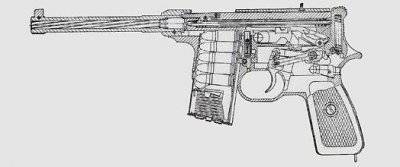 The system of automatic weapons is based on the use of recoil energy in the short course of the barrel. Rather, with a short course of the receiver, but let's deal with this in more detail. The barrel of the weapon is rigidly connected with the receiver, which has the ability to move within the frame of the pistol. In the very same mobile receiver moves the bolt of the weapon, which locks the bore when the larva rotates under the bolt. So in its normal position, the larva is turned in such a way that it catches the shutter with two “teeth” and does not allow it to move, but this is exactly as long as a shot does not occur. When fired, the powder gases, trying to increase the distance between the bullet and the sleeve, expand, respectively, the bullet flies out of the barrel of the weapon, and the sleeve tends to leave the chamber. But since the sleeve itself is fixed by a bolt that engages with the barrel through a movable receiver, the sleeve transmits to all these elements a short-term impulse equal in time to the bullet in the barrel during the shot. So thanks to the mass of the bolt, the receiver and the barrel of the weapon, this momentum is maintained and it is enough to ensure the normal movement of these parts of the weapon. So, the barrel, welded with the receiver, and the bolt of the weapon, which is connected to the moving receiver by means of the locking larva, begin to move backwards. In this case, the locking larva turns around its axis and releases the bolt of the weapon, simultaneously braking the barrel and the receiver. The bolt, moving back, throws out the cartridge case, compresses the return spring and cocks the pistol. Having reached its extreme rear point, the bolt begins to move in the opposite direction, under the action of a return spring. Moving already forward, the bolt removes a new cartridge from the magazine and inserts it into the chamber. Facing into the breech breech, he pushes it along with the receiver, at the same time the locking larva turns in the opposite direction and locks the bore, connecting the barrel and the receiver with the bolt. After that, just pull the trigger so that the next shot occurs, if the translator of fire modes is in the “Automatic fire” position, the next shot will occur automatically and this will happen until the trigger is released.
The system of automatic weapons is based on the use of recoil energy in the short course of the barrel. Rather, with a short course of the receiver, but let's deal with this in more detail. The barrel of the weapon is rigidly connected with the receiver, which has the ability to move within the frame of the pistol. In the very same mobile receiver moves the bolt of the weapon, which locks the bore when the larva rotates under the bolt. So in its normal position, the larva is turned in such a way that it catches the shutter with two “teeth” and does not allow it to move, but this is exactly as long as a shot does not occur. When fired, the powder gases, trying to increase the distance between the bullet and the sleeve, expand, respectively, the bullet flies out of the barrel of the weapon, and the sleeve tends to leave the chamber. But since the sleeve itself is fixed by a bolt that engages with the barrel through a movable receiver, the sleeve transmits to all these elements a short-term impulse equal in time to the bullet in the barrel during the shot. So thanks to the mass of the bolt, the receiver and the barrel of the weapon, this momentum is maintained and it is enough to ensure the normal movement of these parts of the weapon. So, the barrel, welded with the receiver, and the bolt of the weapon, which is connected to the moving receiver by means of the locking larva, begin to move backwards. In this case, the locking larva turns around its axis and releases the bolt of the weapon, simultaneously braking the barrel and the receiver. The bolt, moving back, throws out the cartridge case, compresses the return spring and cocks the pistol. Having reached its extreme rear point, the bolt begins to move in the opposite direction, under the action of a return spring. Moving already forward, the bolt removes a new cartridge from the magazine and inserts it into the chamber. Facing into the breech breech, he pushes it along with the receiver, at the same time the locking larva turns in the opposite direction and locks the bore, connecting the barrel and the receiver with the bolt. After that, just pull the trigger so that the next shot occurs, if the translator of fire modes is in the “Automatic fire” position, the next shot will occur automatically and this will happen until the trigger is released.Despite all the genius of the automation scheme, which was implemented in the Mauser C96 pistol by modern standards, it cannot be called reliable and durable, and if you multiply it into truly mass production, the result will be very, very bad. Actually, this was demonstrated by the Type 80 pistol, despite the fact that this weapon was put into service, it was not widely used for obvious reasons. In addition, the cartridge 7,62х25 was considered ineffective, because the Chinese did not really succeed in reviving the truly legendary weapon model. The weight of this craft was 1160 grams without ammunition and a detachable store. The length of the weapon was equal to 300 millimeters with a barrel length 140 millimeters. The rate of fire was slightly lower than the original pistol and was 800-900 shots per minute. Unfortunately, it is not exactly known whether it was a legal copy of a weapon or “pirated”, so we will not blame for illegal copying.
Shooting gun on board the aircraft - Type-84.
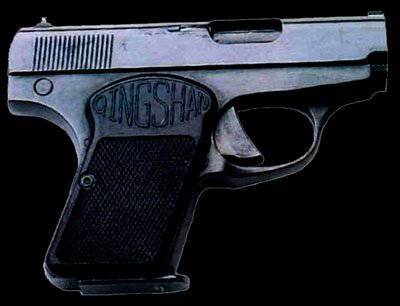 By 1984, the Chinese Ministry of Public Security was concerned about the problem of terrorism in air transport, and therefore it was decided to create a sample of weapons that would be equally effective and safe when firing in the aircraft cabin. Actually there were no problems with weapons, the main problem was the ammunition, which would have enough energy to defeat the enemy even at short distances, but could not pierce the plane. Since China is a country where the time span between the order and its implementation is very small, such an ammunition and a pistol under it were created with a sword than six months later. Unfortunately, there are very few images of this weapon, not to mention the image of the ammunition, although it is completely incomprehensible what could be secret in such a gun, since the gun itself and the ammunition are quite simple devices and do not hide extraterrestrial technologies in themselves. Although given the fact that this weapon still performs its duties, it is correct.
By 1984, the Chinese Ministry of Public Security was concerned about the problem of terrorism in air transport, and therefore it was decided to create a sample of weapons that would be equally effective and safe when firing in the aircraft cabin. Actually there were no problems with weapons, the main problem was the ammunition, which would have enough energy to defeat the enemy even at short distances, but could not pierce the plane. Since China is a country where the time span between the order and its implementation is very small, such an ammunition and a pistol under it were created with a sword than six months later. Unfortunately, there are very few images of this weapon, not to mention the image of the ammunition, although it is completely incomprehensible what could be secret in such a gun, since the gun itself and the ammunition are quite simple devices and do not hide extraterrestrial technologies in themselves. Although given the fact that this weapon still performs its duties, it is correct.As mentioned above, the main feature of this gun is its cartridge. In the short period of time that this munition was developed, the designers had time to experiment with a wide variety of materials, there were fragile alloys and polymers, but in the end the result was a lead half-obstruction with a plastic core. Such a bullet almost immediately collapsed when it hit solid obstacles, so at a distance of two meters it could not under any circumstances harm the aircraft and its equipment. At the same time, it was relatively effective at distances up to 15 meters when firing at a live target, not protected by personal armor. The sleeve of the 7,65x17 ammunition became the cartridge case, and the resulting cartridge can be used in almost all weapon models for this ammunition. Having spent a lot of time with the patron himself, the designers had almost no time left to develop the weapon of genius, so they decided to borrow it again from the already existing samples.
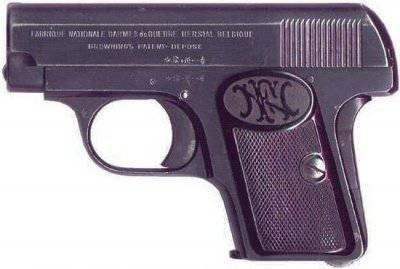 The basis for the new pistol was the once-popular Browning M1906 compact pistol, which uses cartridges of 6,35 caliber of millimeters. However, no one was going to clean the “rip off” weapon, and it was changed a little. First of all, the gun lost its automatic safety device, the key of which was located in the original model on the back of the handle. Of course, the gun was adapted to the new ammunition, because of which the magazine's capacity did not become different and is equal to 5 cartridges. The switch of the automatic fuse was also moved, which was now located on the left side of the gun on the casing-gate, but there was no such variant of the location of the switch of the fuse. Interestingly, the fixation system of the removable barrel was completely repeated in the weapon, in which the barrel entered the grip of the weapon when turning, and in the case of disassembly it was disengaged with it when turning and removed together with the shutter casing. In general, this gun is the simplest type of weapon built on automatics with a free gate. The total length of the gun is 121 millimeter, with barrel length 56 millimeters. The weight of the weapon is 380 grams without ammunition.
The basis for the new pistol was the once-popular Browning M1906 compact pistol, which uses cartridges of 6,35 caliber of millimeters. However, no one was going to clean the “rip off” weapon, and it was changed a little. First of all, the gun lost its automatic safety device, the key of which was located in the original model on the back of the handle. Of course, the gun was adapted to the new ammunition, because of which the magazine's capacity did not become different and is equal to 5 cartridges. The switch of the automatic fuse was also moved, which was now located on the left side of the gun on the casing-gate, but there was no such variant of the location of the switch of the fuse. Interestingly, the fixation system of the removable barrel was completely repeated in the weapon, in which the barrel entered the grip of the weapon when turning, and in the case of disassembly it was disengaged with it when turning and removed together with the shutter casing. In general, this gun is the simplest type of weapon built on automatics with a free gate. The total length of the gun is 121 millimeter, with barrel length 56 millimeters. The weight of the weapon is 380 grams without ammunition.Back it is not known whether anyone received money for using the design of a pistol of the early twentieth century, so shouting “ripped off” is also not worth it. In my opinion, it is much more important that the Chinese designers solved their task at much lower costs, which would have been to create weapons from scratch, not to mention the time that would have been spent on the development of both ammunition and a pistol under him In other words - why reinvent the wheel.
Pistol QSZ 92 and perspective cartridge 5,8х21.
After a short period of time, which was spent on copying and adapting the already existing structures to the pistols' own needs, the Chinese military industry delivered its own weapon, a structure that was rare for pistols and a new ammunition for it. Interestingly, the QSZ 92 pistol was originally designed and a fairly common 9x19 cartridge, however, in addition to this version of the weapon, there was another one designed for smaller-sized ammunition. So, having studied the experience of recent military operations, the Chinese came to the conclusion that the pistol should not only be effective in stopping the action, but also should be able to “work” on targets protected by personal armor protection devices that were widely used and constantly improved. As a result, the task appeared to create a new pistol ammunition, which would successfully cope with the penetration of personal armor, and also had high efficiency when it hit the enemy body. It is from this cartridge that I propose to begin acquaintance with the QSZ 92 pistol.
It should be noted that the main task, in addition to the goals set, was the strictest economy. The new ammunition was supposed to be cheap enough so that it could be made basic for the People’s Liberation Army of China. So one of the main decisions aimed at reducing the cost of not only the specific ammunition, but reducing the cost of producing personal weapons and ammunition, was that the new pistol munition decided to make the same caliber as the newly developed cartridge for the machine gun, that is, caliber 5,8 millimeters. It is noteworthy that in many articles about this ammunition it is mentioned that the main requirement for it was the possibility of breaking through the “helmet of Chinese production at a distance of up to 50 meters.” Frankly speaking, it is hard to believe that such a requirement was a reality, since this cartridge was not intended to shoot at helmets, but to defeat the enemy protected by a bullet-proof vest. By the way, the Chinese are not the first to come up with the idea of creating such an ammunition, something similar was created before them. So, for example, you can pay attention to the Belgian development of a small-caliber pistol and a submachine gun, and many weapons companies "indulged in" small-caliber with very high efficiency, so the Chinese are not the first. However, they were the first to succeed in creating what came into service and became fairly widespread, so only they got to the end, because to create it is only half the story, it is much more difficult to create what was created by the masses while retaining the main characteristics.
The new ammunition, despite the number in its name was created in 1994, the weapon for this cartridge is the QSZ-92 pistol and the QSW-05 submachine gun, which will be discussed in a separate article. Looking at these cartridges one cannot get rid of the idea that we have cartridges for a machine gun, and not for a pistol. A bottle-shaped sleeve, a pointed bullet, all speaks of this except for the size of ammunition. The cartridge is equipped with a relatively light 2,99 gram bullet, but this bullet is heavier compared to the same 5,7x28, although the comparison is not entirely decent, since the Chinese cartridge is incomparable in no way, despite having a close caliber. The initial speed of a bullet is 480 meters per second, which, given its weight, means that the kinetic energy is equal to Xnumx Joule. Honestly, the numbers are not impressive, but the small caliber and the correct bullet device give it a huge advantage over the same 344x9. However, everything is relative and depends on each specific situation. In order not to be misleading and not to repeat possible nonsense, I will not speak about what and at what distance with this cartridge, because I did not find a single source that would give me confidence and at the same time similar information was placed on it .
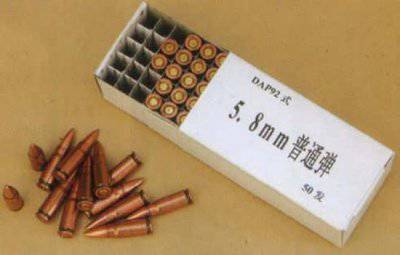 The gun under this ammunition was not created separately, as it was noted above. By the time the work on the new ammunition was completed, it was decided to adapt the already existing QSZ-92 weapon, which was fed with millimeters 9x19 cartridges. As a result of the transition to a new cartridge, the pistol's handle slightly changed its size, but not so much as to become inconvenient, even for the Chinese. After the appearance of a new version of the weapon, the old one, chambered for 9x19, began to be actively exported, the new one was produced, and as far as I know, it is still being produced only for internal needs. In general, the weapon looks quite modern, especially the version for 5,8x21 cartridges. The fact is that the version of this pistol was quite actively developed after the transition to a new ammunition. So in view of the smaller recoil force when shooting, the weapon became not only much more comfortable and controllable, but also received a frame from impact-resistant plastic, and this reduced the weight of the weapon to 760 grams while the gun length is 190 millimeters, with the barrel length 115 millimeters. On the reliability and durability, this did not affect, due to the fact that long plastic guides of steel for the housing-bolt are inserted into the plastic. Rather, it’s not guides, but a single module that houses the weapon’s trigger mechanism. Interestingly, in this sample, the Chinese finally attended to the issue of using weapons by “non-standard” people with the main left hand rather than the right hand and duplicated the fuse switch, which also serves to safely pull the trigger on both sides of the gun. The magazine eject button can also be moved to the other side of the weapon, but the slide latch lever is located only on the left side of the gun. In the version of the weapon chambered for 9x19, the gun magazine has a capacity of 15 cartridges. In the case of 5,8x21 ammunition, the weapons magazine's capacity is 20 ammunition, which is quite a lot for such a weapon that does not have automatic firing, although it depends on which side to look at.
The gun under this ammunition was not created separately, as it was noted above. By the time the work on the new ammunition was completed, it was decided to adapt the already existing QSZ-92 weapon, which was fed with millimeters 9x19 cartridges. As a result of the transition to a new cartridge, the pistol's handle slightly changed its size, but not so much as to become inconvenient, even for the Chinese. After the appearance of a new version of the weapon, the old one, chambered for 9x19, began to be actively exported, the new one was produced, and as far as I know, it is still being produced only for internal needs. In general, the weapon looks quite modern, especially the version for 5,8x21 cartridges. The fact is that the version of this pistol was quite actively developed after the transition to a new ammunition. So in view of the smaller recoil force when shooting, the weapon became not only much more comfortable and controllable, but also received a frame from impact-resistant plastic, and this reduced the weight of the weapon to 760 grams while the gun length is 190 millimeters, with the barrel length 115 millimeters. On the reliability and durability, this did not affect, due to the fact that long plastic guides of steel for the housing-bolt are inserted into the plastic. Rather, it’s not guides, but a single module that houses the weapon’s trigger mechanism. Interestingly, in this sample, the Chinese finally attended to the issue of using weapons by “non-standard” people with the main left hand rather than the right hand and duplicated the fuse switch, which also serves to safely pull the trigger on both sides of the gun. The magazine eject button can also be moved to the other side of the weapon, but the slide latch lever is located only on the left side of the gun. In the version of the weapon chambered for 9x19, the gun magazine has a capacity of 15 cartridges. In the case of 5,8x21 ammunition, the weapons magazine's capacity is 20 ammunition, which is quite a lot for such a weapon that does not have automatic firing, although it depends on which side to look at.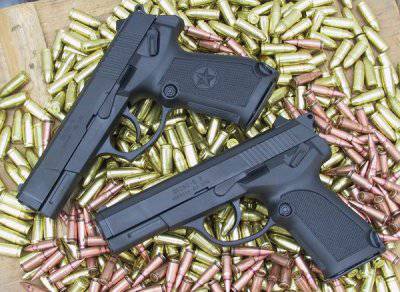 The trigger mechanism of double-action weapons, automatic pistol built on the use of recoil in the short course of the barrel, but what is interesting, the barrel bore locks when the barrel itself is turned. Rotation of the barrel during its movement is carried out by the interaction of the insert with the guide rod of the recoil spring under the barrel of the weapon and the projections in the breech breech. So, when fired, the barrel coupled to the casing receives a pulse from the cartridge case, thanks to which all this happiness is set in motion. Moving back along with the shutter casing, the barrel of the weapon is rotated by the interaction of the projections in its breech and grooves in the insert under the barrel. Due to this there is a disengagement of the barrel and the housing-bolt. The barrel of the weapon stops, and the shutter-casing continues its movement already in proud solitude, removing the cartridge case from the barrel bore and throwing it out, compressing the recoil spring, as well as cocking the trigger of the weapon. Reaching his extreme point, he changes his direction of motion, and under the influence of the return spring begins to move forward. When moving forward, the shutter casing removes the new cartridge from the magazine and inserts it into the chamber. Resting on the breech, he begins to push him forward, which leads back to the interaction of projections in the breech breech and liner under him, and as a result of his port, in which the barrel bore is locked. This scheme is far from being used for the first time in weapons, but it is quite rare, and therefore interesting.
The trigger mechanism of double-action weapons, automatic pistol built on the use of recoil in the short course of the barrel, but what is interesting, the barrel bore locks when the barrel itself is turned. Rotation of the barrel during its movement is carried out by the interaction of the insert with the guide rod of the recoil spring under the barrel of the weapon and the projections in the breech breech. So, when fired, the barrel coupled to the casing receives a pulse from the cartridge case, thanks to which all this happiness is set in motion. Moving back along with the shutter casing, the barrel of the weapon is rotated by the interaction of the projections in its breech and grooves in the insert under the barrel. Due to this there is a disengagement of the barrel and the housing-bolt. The barrel of the weapon stops, and the shutter-casing continues its movement already in proud solitude, removing the cartridge case from the barrel bore and throwing it out, compressing the recoil spring, as well as cocking the trigger of the weapon. Reaching his extreme point, he changes his direction of motion, and under the influence of the return spring begins to move forward. When moving forward, the shutter casing removes the new cartridge from the magazine and inserts it into the chamber. Resting on the breech, he begins to push him forward, which leads back to the interaction of projections in the breech breech and liner under him, and as a result of his port, in which the barrel bore is locked. This scheme is far from being used for the first time in weapons, but it is quite rare, and therefore interesting.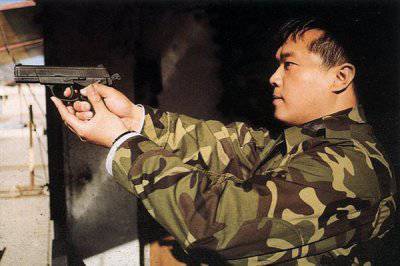
It is very easy to distinguish the QSZ-92 pistol chambered for 5,8x21, from the weapon version chambered for 9x19 according to the safety bracket. So, in the gun for 5,8x21 ammunition, it does not have a deflection in its front, which is the main distinctive chart from which you can determine what kind of weapon it is. For the QSZ-92 pistol, an enormous number of additional devices were developed, including an adapter for using optical and collimator sights, which is fixed under the barrel of the weapon and comes out from above, allowing you to install additional aiming devices so that they are both comfortable to use and not tested loads when fired. I do not know how anyone, but I personally would not have refused such a Chinese pistol, I would add the possibility of automatic fire in it, and in general it would be great.
This can complete the 3 article about pistols from China, there is still a lot of material ahead, so it will be better and more interesting further.
Information